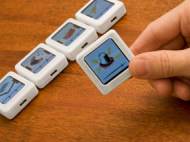Sifteo should enhance children education and creativity
 Imagine overturning a container of nuts and bolts, then looking through the resulting pile for a particular item or spreading photographs out on a tabletop and then beginning to sort them into piles. The Nintendo Wii remote control and Microsoft’s Surface multi-touch display have begun to change the way we interact with computers, but even these give us feedback in a conventional way. Sifteo (previously named Siftables) present a different approach used in interacting with information created by David Merrill and Jeevan Kalanithi at the MIT Media Lab. Their mentor is Pattie Maes, the person who mentored another information interaction project named SixthSense which we described earlier.
Imagine overturning a container of nuts and bolts, then looking through the resulting pile for a particular item or spreading photographs out on a tabletop and then beginning to sort them into piles. The Nintendo Wii remote control and Microsoft’s Surface multi-touch display have begun to change the way we interact with computers, but even these give us feedback in a conventional way. Sifteo (previously named Siftables) present a different approach used in interacting with information created by David Merrill and Jeevan Kalanithi at the MIT Media Lab. Their mentor is Pattie Maes, the person who mentored another information interaction project named SixthSense which we described earlier.
Sifteo aim to enable people to interact with information and media in physical, natural ways that approach interactions with physical objects in our everyday lives. As an interaction platform, Siftables applies technology and methodology from wireless sensor networks to tangible user interfaces. Siftables are independent, compact devices with sensing, graphical display, and wireless communication capabilities. They can be physically manipulated as a group to interact with digital information and media. Siftables can be used to implement any number of interaction languages which use gestures and HCI applications.
“I wanted to build a new human-computer interface that would take advantage of our abilities to grasp objects, move them around and understand the spatial relationships between them,” Merrill says. “Many of these skills are underutilized.”
Each siftable measures about 5-centimetres square and is fitted with an LCD screen, battery, memory, an accelerometer which detects motion, a Bluetooth radio which is used for communication with other computers, and an infrared link which is used to detect the presence and orientation of neighboring siftables. Each block has its own small amount of built-in computing power.
A group of siftables can be programmed to either solve problems independently, or take their orders from a desktop computer, in which case the way the pieces are moved around also controls an application running on the computer.
Merrill says the devices are likely to be used initially for games. “Gaming is often an area where new interfaces take hold,” he says, “because people are more willing to try something new in a play setting than at work.” We also find this feature more relevant because it is more likely to be used by children who could solve math problems, play word games or even invent stories they could share (or use for their own entertainment).
He has already developed a siftables word game. Each piece displays a randomly assigned letter, and the user has to move pieces around to form words as quickly as possible. The pieces communicate with each other to keep track of the words being formed, which are checked against a built-in dictionary. When the player forms a valid word, the siftables highlight the relevant pieces.
Producing music is another potential application. Merrill and Josh Kopin of Brown University in Providence, Rhode Island, used siftables to build a user interface for a music sequencer running on a desktop computer. You can create sequences or adjust volume or tempo but, though it could be used to improve creativity of children, it doesn’t show a great potential in music production business.
We hope that the siftables will be affordable and have more focus on the market related to the children and their education and creativity, as well as the puzzle and social games for adults. For more resources visit this page.










This is an amazing little device, i can’t wait to get a set and start using it. The possibilities are endless.. especially in a school / educational system / environment! Anyone know when the release date is for these?
That’s is absolutly excellent tiny device, every one can start using it. It is very useful in sector of educations, schools and others. I think most of the people are waiting for the release this great device. Let me come to on your video that is shows detailed information about that device. Best grade for this video.